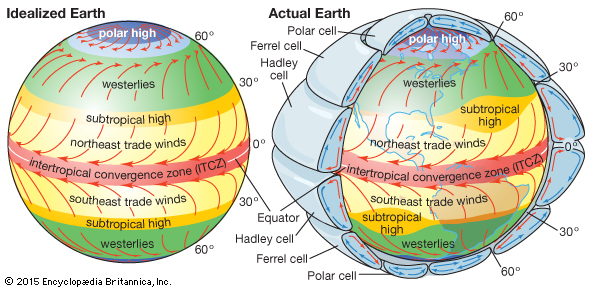Deforestation at high latitudes could impact monsoons
By Julia Rothchild
Russians don’t usually worry about monsoons. But a new study says maybe they should. Research suggests that deforestation in the far north could significantly impact South Asian monsoon rainfall.
The study, published last month in the Proceedings of the National Academy of Sciences, used an idealized climate model to show how cutting down trees at high latitudes might change monsoon circulations.
The researchers found that heavy deforestation would shift what is called the Intertropical Convergence Zone (ITCZ) towards the south. The ITCZ is a band of clouds and precipitation circling the globe where the northeast and southeast trade winds converge and rise. It hovers near the equator, but migrates hundreds to thousands of miles north and south of the equator during the course of the seasonal cycle. The ITCZ’s movement determines where and when monsoons occur.
The ITCZ lies north of the equator during June, July, August, and September, when the northern hemisphere’s summer occurs and the warm, rising air lies in the northern hemisphere. During that time, monsoons occur north of the equator. In December, January, February, and March, the ITCZ moves south, and showers the southern hemisphere with monsoon rain during its summer.
Deforestation would push the ITCZ south by providing a remote forcing. Cutting down dark green forests exposes land, and bare land reflects more sunlight than the original forests. In other words, deforestation increases the albedo of the Earth’s surface. The result is less solar absorption, and an energy deficit in the northern hemisphere’s high latitude systems. This causes the ITCZ to shift away from the imposed energy sink.
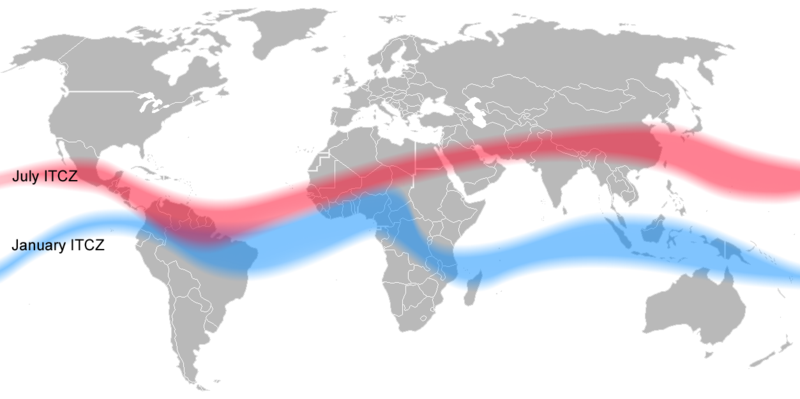
The idea that the ITCZ might move to the north or south in response to a high-latitude heat source or sink is not new. Numerous studies have shown that an expansion of reflective ice cover in the northern hemisphere would shift the ITCZ southward. It is thought that the decades-long drought in Africa’s Sahel resulted from a southward shift in Africa’s monsoon precipitation, which was caused by temperature changes in the Atlantic Ocean – cooling north of the equator, and warming south of it. These and other studies relating shifts in tropical precipitation to cross-equatorial gradients in energy sources were reviewed here.
A southward shift of the ITCZ would mean that many places in the northern hemisphere that rely on monsoon rains would receive less precipitation. These places include North America, North Africa, and South Asia. In the study’s ideal climate model, northern deforestation causes the rainfall over India in particular to decline by 18%. Correspondingly, the southern hemisphere monsoon regions – South Africa, South America, and Australia – would experience a precipitation increase. It should be noted that the model assumed drastic, major deforestation, in which all trees north of 50 degrees latitude were eliminated and replaced by grasses. But in places that rely on monsoons for life, even a precipitation change of less than 18% would have major impacts on livelihood: droughts and floods plague India when the summer rainfall is only ten percent weaker or stronger than usual.
The study found that far-away deforestation actually has more of an impact on the South Asian monsoon region than does local land surface changes in South Asia. In other words, land changes in India might have less effect on Indian monsoons than deforestation in Russia. We focus on Russia because that particular country has the most forested area of any state on Earth. About 20,000 square kilometers in Russia alone are deforested every year.
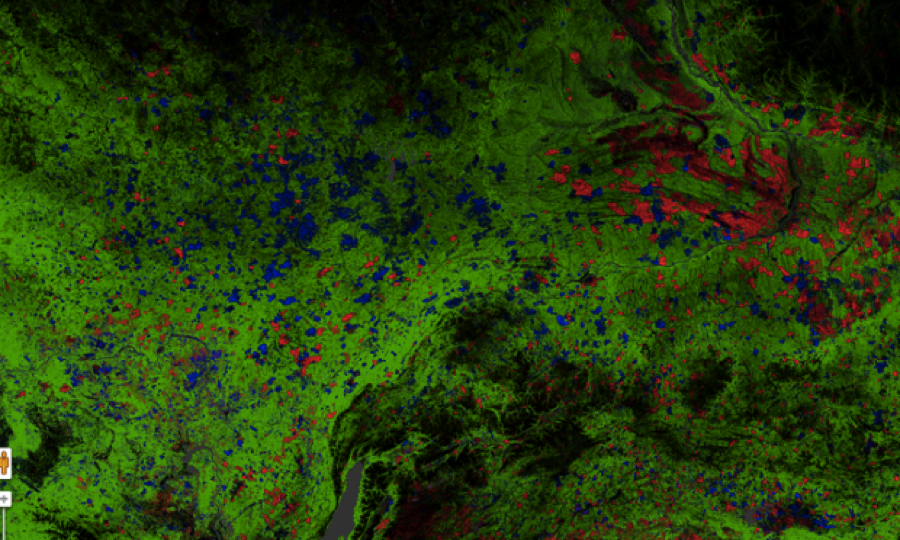
The upshot is that people living in India might have less environmental control over the monsoons than people in Russia. This seems not only unintuitive, but politically inconvenient: the people who may be most affected by northern latitude deforestation – Indians, for example – have little say in its occurrence.
The idea that land surface albedo changes might affect monsoons is not new, and it is unclear whether realistic amounts of deforestation would have an appreciable effect on monsoons. Still, this study emphasizes the truly global nature of climate change issues. Maintaining a climate that is healthy for human populations cannot be accomplished by one country alone.
Drought in São Paulo: Causes and Effects
By Julia Rothchild
About a year ago in the Bolivian Amazon, floodwaters washed away the homes and property of 150,000 people. But right now, just 1500 miles away, inhabitants of São Paulo are experiencing the worst drought in decades. Last week, residents drilled through their own basement floors, hoping to find groundwater available for drinking. The city’s main water utility has lowered the water pressure in pipes so that people use less.

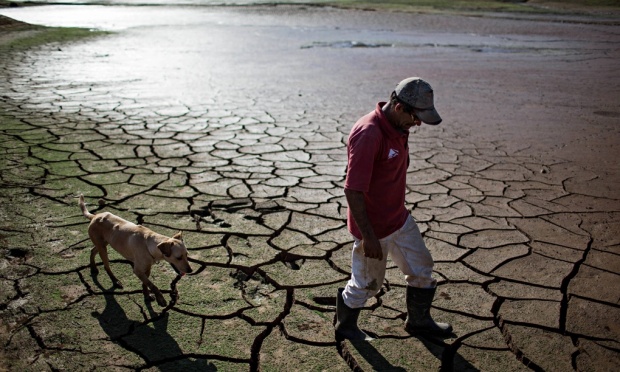
The causes of these two recent South American weather extremes may be connected. Some meteorologists have argued that the flood and the drought could be explained by a meteorological phenomenon in which the usual migration of high- and low-pressure systems is disrupted. This is called “atmospheric blocking,” and usually happens when a high-pressure system stops moving across the globe and hovers in the mid-latitudes. Because it is stuck in one place, the system blocks the normal travel of weather systems from west to east.
The floods may have been caused when winds, forced to rotate around a stationary system, brought moisture-laden air into the Bolivian Amazon. The same process may have led to the drought in São Paulo, as winds carrying precipitation haven’t been able to reach the area. That means there’s almost no water in the air over that part of Brazil, and therefore little rain.
The map below shows how much atmospheric pressure has deviated from the norm over the past six months. The culprit – a high-pressure area shaded in red – hovers just southeast of Brazil. This “block” of air drives normal wind patterns into a meteorological traffic jam, in which some air becomes stuck where it shouldn’t be. Wind flowing counter-clockwise skirts around the edges of this high, and brings dry air from outside the tropics into South America.
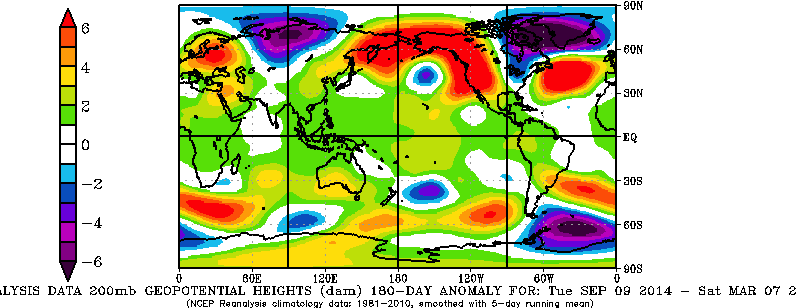
(As an aside, it is interesting to note that the dark purple shading over northeastern Canada indicates that there is a low-pressure system there. The very cold winter in the eastern U.S. this year is associated with this northern hemisphere low. Air flows counter-clockwise around this area, bringing cold arctic air into central and eastern North America.)
Scientists attribute the recent Bolivian flood and Brazilian drought to a single event of atmospheric blocking, as opposed to the wider trend of man-made climate change. But some think that what is considered an anomaly now could become commonplace if the world’s temperatures keep rising.
The current São Paulo drought is ravaging the city. Nine million people rely on the Cantareira reservoir system, which is currently only 5% full. Another three million usually receive water from the Alto Tietê reservoir network, which is less than 15% full. The government has proposed rationing water, so that every week residents of São Paulo have two days with water and five days without.
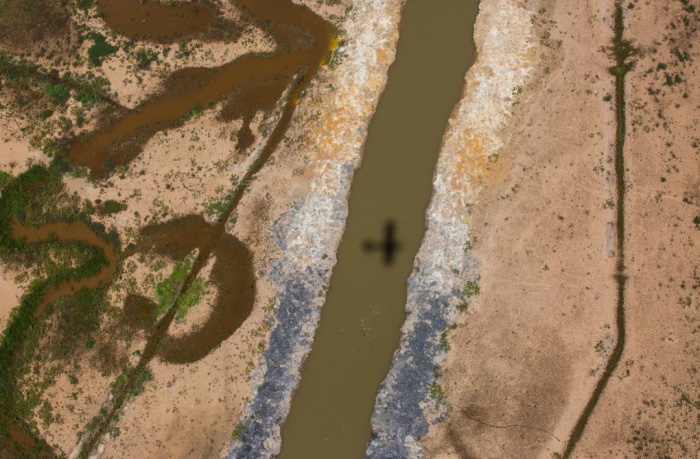
Inhabitants of São Paulo have responded to governmental water restrictions by hoarding the water they can find in containers. These buckets and watering cans are often left open outside, and as such, they have become ideal places for mosquitoes to breed. In a seemingly paradoxical twist, the drought has created a haven for mosquitoes that thrive in wet conditions.
This is a huge problem because many mosquitoes in the region carry dengue fever, which causes high fever and muscle convulsions. The incidence of disease is up 163% from last year. In some parts of the São Paulo state, the figure is worse, and officials are calling this an epidemic.
The Brazilian water crisis is a result of uncontrollable weather patterns, but is exacerbated by a failure of resource management. Environmental advocates have attempted to put an end to practices that pollute areas of water production. But according to some, the Brazilian government heavily supports efforts to expand exports of soya, beef, and pig iron and focuses less on environmental issues. These industries are the cause of much of the deforestation and greenhouse gas emission in the country, which may lead to even worse droughts in the future.
How monsoons drive life in the Western Ghats
By Julia Rothchild
In the mountains of southern India, the grass really is greener on the other side. The Western Ghats, a mountain range that runs for 1,600 kilometers along the western coast, support much more plant and animal life on one side than the other. The ecological contrast is due in part to the heavy rains that sweep over the country for several months every year.
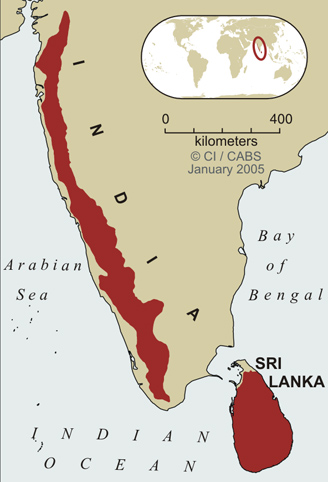
During monsoon season, the side of the Western Ghats mountain range that faces the Arabian Sea is covered in dense deciduous and evergreen forests. The earth blooms with thousands of species of flowering plants. The macaque, Asian elephant, purple frog, and crimson-backed sunbird all find a home among the verdure. The rivers and lakes are full.
The other side of the Western Ghats – the side that faces most of the Indian peninsula – is parched by comparison. Brown savannas cover the earth. The diversity of flora and fauna is more limited.


This natural disparity – more pronounced in some areas than in others – arises because of the way monsoons make their way towards the mainland at the end of every spring. Air near Earth’s surface flows northward from the winter hemisphere toward the Asian land mass that is heated by the summer sun. The Coriolis force turns this air to the right to become the low-level “monsoon westerlies” – eastward winds that constitute the lower branch of the monsoon circulation. These winds are laden with moisture, and travel across the Arabian Sea towards India. About 40 kilometers inland, the air is confronted with the massive chain of mountains, which act as a tall barricade. In order to cross the mountain range, like any good hiker, the monsoon air must trudge up and over. While the air climbs the slopes, much of its moisture falls as rain. When it reaches the other side, the air has been depleted of moisture, which means the climate is more arid east of the peaks.
Due in large part to the huge amount of rainfall on their windward side, the Ghats are one of the world’s eight “hottest hotspots” of biological diversity. Around 5,000 species of vascular plants alone grow there, as do hundreds of species of mammals, reptiles, birds, and amphibians. A large number of these species are endemic to the Ghats: they are found nowhere else in the world. The monsoons therefore nourish an exceptionally vibrant pocket of life. They enable a hotspot of biodiversity, saturated with water, to thrive.

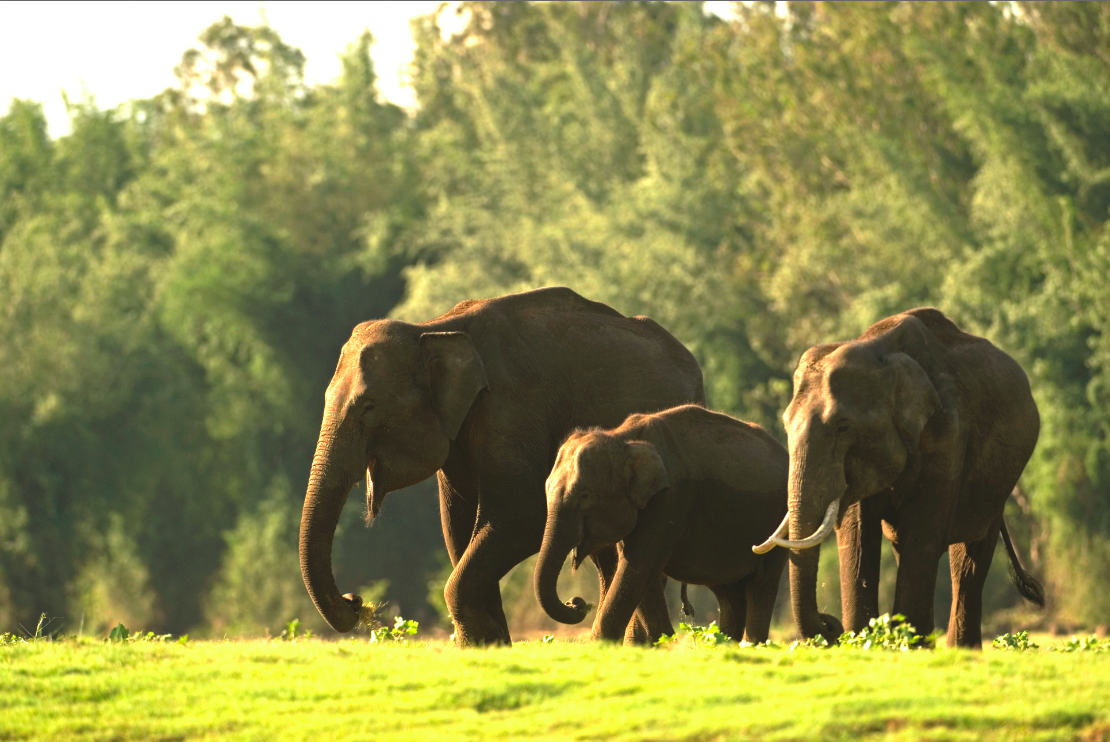
But when the clouds are less generous, both on the drier side of the mountains and during the dry winter months, both wildlife and human life suffer. Drier air means fewer crops and, depending on the area, perhaps less business or more hunger.
Within the past month, it has been reported that farmers in the state of Maharashtra, of which Mumbai is the capitol, are suffering severely from a drought. Sixty percent of villages are currently facing “drought-like conditions,” and the state and Central government are attempting to find relief and aid money. This is the fourth drought in the state since 2008, and agricultural production in the area may be cut in half.
Is there a way to help farmers in areas prone to droughts? To predict anomalies in the Western Ghats, modeling monsoon behavior is critical. Current models are imperfect because of the number and complexity of factors involved. These factors include the starting temperatures of sea air and land air, the contour of the mountains, the size and depth of clouds, and the microscopic interactions between water droplets in the air. The enormous range of variables gives us some idea of the vast challenge climate scientists face when attempting to predict the outcome of the upcoming monsoon season in southern India. As research finds more effective methods to model each of these processes, we hope that predictions of how monsoon air behaves in any given season will improve, and with them the lives of people living in the shadow of the Western Ghats.
